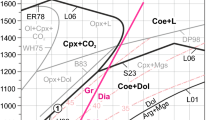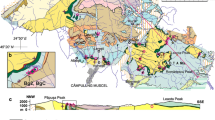Abstract
The solubility of chromium in chlorite as a function of pressure, temperature, and bulk composition was investigated in the system Cr2O3–MgO–Al2O3–SiO2–H2O, and its effect on phase relations evaluated. Three different compositions with X Cr = Cr/(Cr + Al) = 0.075, 0.25, and 0.5 respectively, were investigated at 1.5–6.5 GPa, 650–900 °C. Cr-chlorite only occurs in the bulk composition with X Cr = 0.075; otherwise, spinel and garnet are the major aluminous phases. In the experiments, Cr-chlorite coexists with enstatite up to 3.5 GPa, 800–850 °C, and with forsterite, pyrope, and spinel at higher pressure. At P > 5 GPa other hydrates occur: a Cr-bearing phase-HAPY (Mg2.2Al1.5Cr0.1Si1.1O6(OH)2) is stable in assemblage with pyrope, forsterite, and spinel; Mg-sursassite coexists at 6.0 GPa, 650 °C with forsterite and spinel and a new Cr-bearing phase, named 11.5 Å phase (Mg:Al:Si = 6.3:1.2:2.4) after the first diffraction peak observed in high-resolution X-ray diffraction pattern. Cr affects the stability of chlorite by shifting its breakdown reactions toward higher temperature, but Cr solubility at high pressure is reduced compared with the solubility observed in low-pressure occurrences in hydrothermal environments. Chromium partitions generally according to \(X_{\text{Cr}}^{\text{spinel}}\) ≫ \(X_{\text{Cr}}^{\text{opx}}\) > \(X_{\text{Cr}}^{\text{chlorite}}\) ≥ \(X_{\text{Cr}}^{\text{HAPY}}\) > \(X_{\text{Cr}}^{\text{garnet}}\). At 5 GPa, 750 °C (bulk with X Cr = 0.075) equilibrium values are \(X_{\text{Cr}}^{\text{spinel}}\) = 0.27, \(X_{\text{Cr}}^{\text{chlorite}}\) = 0.08, \(X_{\text{Cr}}^{\text{garnet}}\) = 0.05; at 5.4 GPa, 720 °C \(X_{\text{Cr}}^{\text{spinel}}\) = 0.33, \(X_{\text{Cr}}^{\text{HAPY}}\) = 0.06, and \(X_{\text{Cr}}^{\text{garnet}}\) = 0.04; and at 3.5 GPa, 850 °C \(X_{\text{Cr}}^{\text{opx}}\) = 0.12 and \(X_{\text{Cr}}^{\text{chlorite}}\) = 0.07. Results on Cr–Al partitioning between spinel and garnet suggest that at low temperature the spinel- to garnet-peridotite transition has a negative slope of 0.5 GPa/100 °C. The formation of phase-HAPY, in assemblage with garnet and spinel, at pressures above chlorite breakdown, provides a viable mechanism to promote H2O transport in metasomatized ultramafic mélanges of subduction channels.












Similar content being viewed by others
References
Arcay D, Tric E, Doin M-P (2007) Slab surface temperature in subduction zones: influence of the interplate decoupling depth and upper plate thinning processes. Earth Planet Sci Lett 255:324–338
Artioli G, Fumagalli P, Poli S (1999) The crystal structure of Mg8(Mg2Al2)Al8Si12(O, OH)56 pumpellyite and its relevance in ultramafic systems at high pressures. Am Mineral 84:1906–1914
Baker J, Holland TJB (1996) Experimental reversals in chlorite compositions in divariant MgO+Al2O3+SiO2+H2O assemblages. Am Mineral 81:676–684
Bebout GE (2007) Metamorphic chemical geodynamics of subduction zones. Earth Planet Sci Lett 260:373–393
Brey GP, Doroshev AM, Girnis AV, Turkin AI (1999) Garnet–spinel–olivine–orthopyroxene equilibria in the FeO–MgO–Al2O3–SiO2–Cr2O3 system: I. Composition and molar volumes of minerals. Eur J Mineral 11:599–617
Bromiley GD, Pawley AR (2002) The high-pressure stability of Mg-sursassite in a model hydrous peridotite: a possible mechanism for the deep subduction of significant volumes of H2O. Contrib Mineral Petrol 142:714–723
Brown BE, Bailey SW (1963) Chlorite polytypism: II. Crystal structure of a one-layer Cr-chlorite. Am Mineral 48:42–61
Burns RG (1993) Mineralogical applications of crystal field theory, 2nd edn. Cambridge University Press, Cambridge, UK
Canil D, O’Neill HStC (1996) Distribution of ferric iron in some upper-mantle assemblages. J Petrol 37:609–635
Chatterjee ND, Terhart L (1985) Thermodynamic calculation of peridotite phase relations in the system MgO−Al2O3−SiO2−Cr2O3, with some geological applications. Contrib Mineral Petrol 89:273–284
Doroshev AM, Brey GP, Girnis AV, Turkin AI, Kogarko LN (1997) Pyrope-knorringite garnets in the Earth’s Mantle: experiments in the MgO–Al2O3–SiO2–Cr2O3 system. Russ Geol Geophys 38:559–586
Fockenberg T (1995) New experimental results up to 100 kbar in the system MgO–Al2O3–SiO2–H2O (MASH): preliminary stability fields of chlorite, chloritoid, staurolite, MgMgAl-pumpellyite, and pyrope. Bochumer Geologische und Geotechnische Arbeiten 44:39–44
Fockenberg T (1998) An experimental study of the pressure-temperature stability of MgMgAl-pumpellyite in the system MgO–Al2O3–SiO2–H2O. Am Mineral 83:220–227
Fockenberg T (2008) Pressure-temperature stability of pyrope in the system MgO–Al2O3–SiO2–H2O. Eur J Mineral 20:735–744
Fumagalli P, Poli S (1999) Phase relationships in hydrous peridotites at high pressure: preliminary results of multianvil experiments. Per Mineral 68:275–286
Fumagalli P, Poli S (2005) Experimentally determined phase relations in hydrous peridotites to 6.5 GPa and their consequences on the dynamics of subduction zones. J Petrol 45:1–24
Fumagalli P, Zanchetta S, Poli S (2009) Alkali in phlogopite and amphibole and their effects on phase relations in metasomatized peridotites: a high-pressure study. Contrib Mineral Petrol 158:723–737
Gemmi M, Fischer JK, Merlini M, Poli S, Fumagalli P, Mugnaioli E, Kolbe U (2011) A new hydrous Al-bearing pyroxene as a water carrier in subduction zones. Earth Planet Sci Lett 310:422–428
Gerya TV, Meilick FI (2011) Geodynamic regimes of subduction under an active margin: effects of rheological weakening by fluids and melts. J Metamorph Geol 29:7–31
Girnis AV, Brey GP (1999) Garnet-spinel-olivine-orthopyroxene equilibria in the FeO–MgO–Al2O3–SiO2–Cr2O3 system: II. Thermodynamic analysis. Eur J Mineral 11:619–636
Gottschalk M, Fockenberg T, Grevel K-D, Wunder B, Wirth R, Schreyer W, Maresch WV (2000) Crystal structure of the high-pressure phase Mg4(MgAl)Al4[Si6O21/(OH)7]: an analogue of sursassite. Eur J Mineral 12:935–945
Grove TL, Chatterjee N, Parman SW, Médard E (2006) The influence of H2O on mantle wedge melting. Earth Planet Sci Lett 249:74–89
Hamilton DL, Henderson CMB (1968) The preparation of silicate composition by gelling method. Mineral Mag 36:832–838
Hammersley AP, Svensson SO, Hanfland M, Fitch AN, Häusermann D (1996) Two-dimensional detector software: from real detector to idealised image or two-theta scan. High Press Res 14:235–248
Hervig RL, Smith JV (1982) Temperature-dependent distribution of Cr between olivine and pyroxenes in lherzolite xenoliths. Contrib Mineral Petrol 81:184–189
Jenkins DM (1981) Experimental phase relations of hydrous peridotites modelled in the system H2O–CaO–MgO–Al2O3–SiO2. Contrib Mineral Petrol 77:166–176
Jenkins DM, Chernosky JV Jr (1986) Phase equilibria and crystallochemical properties of Mg-chlorite. Am Mineral 71:924–936
Klemme S (2004) The influence of Cr on the garnet-spinel transition in the Earth’s mantle: experiments in the system MgO–Cr2O3–SiO2 and thermodynamic modelling. Lithos 77:639–646
Klemme S, O’Neill HSC (2000) The effect of Cr on the solubility of Al in orthopyroxene: experiments and thermodynamic modelling. Contrib Mineral Petrol 140:84–98
Kumar N, Reisberg L, Zindler A (1996) A major and trace element and Sr, Nd and Os isotopic study of a thick pyroxenite layer from the Beni Bousera ultramafic complex of N. Morocco. Geochim et Cosmochim Acta 60:1429–1444
Lapham DM (1958) Structural and chemical variation in chromium chlorite. Am Mineral 43:921–956
Larson AC, Von Dreele RB (1994) General structure analysis system (GSAS), Los Alamos National Laboratory Report LAUR 86-748
Marschall HR, Schumacher JC (2012) Arc magmas sourced from mélange diapirs in subduction zones. Nat Geosci 15:862–867
Meyer HOA (1975) Chromium and the genesis of diamond. Geochim Cosmochim Acta 39:929–936
Mukasa SB, Shervais JW (1999) Growth of subcontinental lithosphere: evidence from repeated dike injections in the Balmuccia lherzolite massif, Italian Alps. Lithos 48:287–316
Niida K, Green DH (1999) Stability and chemical composition of pargasitic amphibole in MORB pyrolite under upper mantle conditions. Contrib Mineral Petrol 135:18–40
Nixon PH, Hornung G (1968) A new chromium garnet end member, knorringite from kimberlite. Am Mineral 53:1833–1840
O’Neill HStC, Palme H (1998) Composition of the silicatae Earth: implications for accretion and core formation. In: Jackson I (ed) The Earth’s mantle: composition, structure and evolution. Cambridge University Press, Cambridge, pp 3–126
Pawley A (2003) Chlorite stability in mantle peridotite: the reaction clinochlore + enstatite = forsterite + pyrope + H2O. Contrib Mineral Petrol 144:449–456
Peacock SM (2001) Are the lower planes of double seismic zones caused by serpentine dehydration in subducting oceanic mantle? Geology 29:299–302
Pearson DG, Davies GR, Nixon PH (1993) Geochemical constraints on the petrogenesis of diamond facies pyroxenites from Beni Bousera peridotite massif, North Morocco. J Petrol 34:125–172
Phillips TL, Loveless JK, Bailey SW (1980) Cr3+ coordination in chlorites; a structural study of ten chromian chlorites. Am Mineral 65:112–122
Ravna EJK (2006) Prograde garnet-bearing ultramafic rocks from the Tromsø Nappe, northern Scandinavian Caledonides. Lithos 92:336–356
Schreyer W, Maresch WV, Medenbach O, Baller T (1986) Calcium-free pumpellyite, a new synthetic hydrous Mg–Al-silicate formed at high pressures. Nature 321:510–511
Sinigoi S, Comin-Chiaramonti P, Demarchi G, Siena F (1983) Differentiation of partial melts in the mantle: evidence from the Balmuccia peridotite, Italy. Contrib Mineral Petrol 82:351–359
Smith D (2010) Antigorite peridotite, metaserpentinite, and other inclusions within diatremes on the Colorado Plateau, SW USA: implications for the mantle wedge during low-angle subduction. J Petrol 51:1355–1379
Sobolev NV, Logvinova AM, Zedgenizov DA, Seryotkin YV, Yefimova ES, Floss C, Taylor LA (2004) Mineral inclusions in microdiamonds and macrodiamonds from kimberlites of Yakutia: a comparative study. Lithos 77:225–242
Spandler C, Hermann J, Faure K, Mavrogenes JA, Arculus RJ (2008) The importance of talc and chlorite ‘‘hybrid’’ rocks for volatile recycling through subduction zones; evidence from the high-pressure subduction mélange of New Caledonia. Contrib Mineral Petrol 155:181–198
Stachel T, Harris JW (2008) The origin of cratonic diamonds—constraints from mineral inclusions. Ore Geol Rev 34:5–32
Stalder R, Ulmer P, Thompson AB, Günther D (2001) High pressure fluids in the system MgO–SiO2–H2O under upper mantle conditions. Contrib Mineral Petrol 140:607–618
Staudigel H, Schreyer W (1977) The upper thermal stability of clinochlore, Mg5Al[AlSi3O10](OH8), at 10–35 kb PH2O. Contrib Mineral Petrol 61:187–198
Suzaki J, Akaogi M, Akimoto S, Shimomura O (1985) Garnet-perovskite transformation in CaGeO3: in situ X-ray measurements using synchrotron radiation. Geophys Res Lett 12:729–732
Till C, Grove T, Withers AC (2012) The beginnings of hydrous mantle wedge melting. Contrib Mineral Petrol 163:669–688
Ulmer P, Trommsdorff V (1999) Phase relations of hydrous mantle subducting to 300 km. In: Fei Y-W, Bertka C, Mysen BO (eds) Mantle petrology: field observations and high pressure experimentation: a Tribute to Francis R. (Joe) Boyd. Geochem Soc Spec Publ 6:259–281
Voshage H, Sinigoi S, Mazzucchelli M et al (1988) Isotopic constraints on the origin of ultramafic and mafic dikes in the Balmuccia peridotite (Ivrea Zone). Contrib Mineral Petrol 100:261–267
Webb SA, Wood BJ (1986) Spinel-pyroxene-garnet relationships and their dependence on Cr/Al ratio. Contrib Mineral Petrol 92:471–480
Welch MD, Crichton WA (2005) A high-pressure polytypic transformation in type-I chlorite. Am Mineral 90:1139–1145
Wood BJ, Yuen DA (1983) The role of lithospheric phase transitions on seafloor flattening at old ages. Earth Planet Sci Lett 66:303–314
Zhang J, Li B, Utsumi W, Liebermann RC (1996) In situ X-ray observations on the coesite-stishovite transition: reversed phase boundary and kinetics. Phys Chem Minerals 23:1–10
Ziberna L, Klemme S, Nimis P (2013) Garnet and spinel in fertile and depleted mantle: insights from thermodynamic modeling. Contrib Mineral Petrol 166:411–421
Acknowledgments
The authors wish to thank Andrea Risplendente for assistance at electron microprobe. The authors are thankful to H. Marschall, S. Klemme, and D. Jenkins for their review and to Max W. Schmidt for his valuable work as editor. The authors acknowledge ESRF for experimental activity (EC734 experiment; BM08 and ID09 in-house research time). This work was supported by the Italian Ministry of Education, University and Research (MIUR) [PRIN-2009XRH8JJ].
Author information
Authors and Affiliations
Corresponding author
Additional information
Communicated by T. L. Grove.
Electronic supplementary material
Below is the link to the electronic supplementary material.
Rights and permissions
About this article
Cite this article
Fumagalli, P., Poli, S., Fischer, J. et al. The high-pressure stability of chlorite and other hydrates in subduction mélanges: experiments in the system Cr2O3–MgO–Al2O3–SiO2–H2O. Contrib Mineral Petrol 167, 979 (2014). https://doi.org/10.1007/s00410-014-0979-5
Received:
Accepted:
Published:
DOI: https://doi.org/10.1007/s00410-014-0979-5




